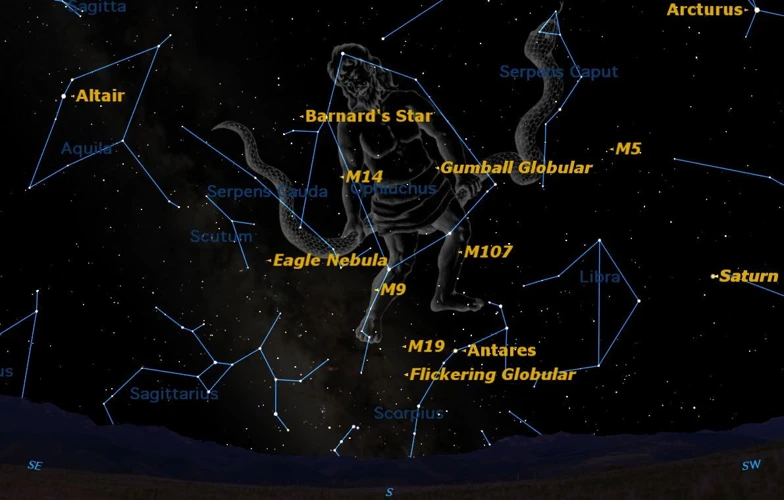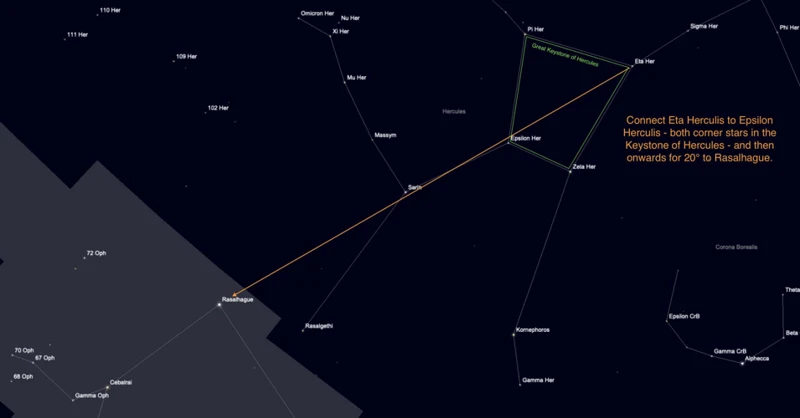It’s a mesmerizing sight, looking up at the night sky and witnessing the beauty of the stars twinkling above. But for beginners, deciphering the constellations can be a perplexing task. Fear not, as we delve into the world of Southern Hemisphere constellations, guiding you through step by step. Understanding these celestial patterns is the first key to unlocking the wonders of the night sky. From locating key constellations to using guide stars and asterisms, we will equip you with the knowledge needed to navigate the Southern Hemisphere night sky like a seasoned stargazer. So, grab your telescope, adjust your eyes to the darkness, and let’s embark on this celestial adventure together.
Contents
- Understanding Constellations
- Navigating the Night Sky
- Notable Southern Hemisphere Constellations
- Conclusion
-
Frequently Asked Questions
- 1. What are some well-known constellations in the Southern Hemisphere?
- 2. Can I see the same constellations from different parts of the Southern Hemisphere?
- 3. How can I locate constellations in the Southern Hemisphere?
- 4. Are there any specific constellations visible only from the Southern Hemisphere?
- 5. Can I observe constellations all year round in the Southern Hemisphere?
- 6. What tools do I need for stargazing in the Southern Hemisphere?
- 7. How can I make stargazing more enjoyable?
- 8. Can I see planets in the Southern Hemisphere?
- 9. Are there any myths or stories associated with Southern Hemisphere constellations?
- 10. How can I involve children in observing constellations in the Southern Hemisphere?
- References
-
Frequently Asked Questions
- 1. Can I see the same constellations in the Southern Hemisphere as in the Northern Hemisphere?
- 2. Are there any specific constellations that are only visible in the Southern Hemisphere?
- 3. How do I locate constellations in the night sky?
- 4. What are some tips for stargazing in the Southern Hemisphere?
- 5. Why are constellations important in navigation?
- 6. Which Southern Hemisphere constellation is known for its distinct cross shape?
- 7. What is the significance of Orion the Hunter in Southern Hemisphere stargazing?
- 8. Why is Scorpius the Scorpion an important Southern Hemisphere constellation?
- 9. How does Centaurus the Centaur differ from other Southern Hemisphere constellations?
- 10. Can I see all the Southern Hemisphere constellations from anywhere in the Southern Hemisphere?
- References
- Read More
Understanding Constellations

The night sky is a vast canvas adorned with a myriad of constellations, each telling a unique story. But what exactly are constellations? These are patterns formed by stars in the sky, typically representing mythological figures, animals, or objects. They serve as celestial landmarks, helping astronomers and stargazers navigate the vastness above. Constellations have played a significant role throughout human history, as they have guided sailors, influenced ancient mythology, and continue to inspire awe and wonder in people today. Understanding the significance of constellations, particularly in the Southern Hemisphere, allows us to delve deeper into the celestial realm and unravel the secrets of the night sky. So, let’s explore the enchanting world of constellations and how their stories connect us to the cosmos.
1. What are Constellations?
Constellations are mesmerizing patterns formed by groups of stars in the night sky. These celestial arrangements have captivated humans since ancient times, serving as guides for navigation and storytelling. Mythological figures, animals, and objects are often represented by these stellar configurations, creating a celestial tapestry of wonder. Constellations are not limited to a specific culture or era, as they can be observed and appreciated by people from different parts of the world. They have played a significant role in navigation, helping sailors traverse the seas and aiding explorers in their quests. In addition to their practical uses, constellations hold great importance in astronomy, allowing scientists to map and study the stars. Understanding the formation and history of constellations provides us with a deeper connection to the vastness of the universe and the mysteries it holds. So, let’s embark on a journey to unravel the secrets of these cosmic patterns and explore the awe-inspiring world of constellations.
2. Importance of Southern Hemisphere Constellations
Southern Hemisphere constellations hold a unique significance in the world of astronomy and stargazing. While many popular constellations, such as Ursa Major or Orion, are visible from both the Northern and Southern Hemispheres, there are several constellations that are exclusive to the Southern Hemisphere. These include iconic formations like the Southern Cross (Crux) and Centaurus. The importance of Southern Hemisphere constellations lies in their cultural and navigational significance. For centuries, these constellations have been used by navigators and explorers to navigate the vast oceans, guiding their journeys across the Southern Hemisphere. Additionally, these constellations hold immense cultural value for the indigenous peoples of the region, who have weaved their stories and legends around them. By understanding and appreciating Southern Hemisphere constellations, we gain a deeper connection to the rich history and cultural heritage of the southern skies. So, let us explore these celestial wonders as we embark on a journey through the Southern Hemisphere night sky.

Navigating the night sky may seem like a daunting task, but with a few key techniques, you can become a skilled celestial traveler. To begin with, locating key Southern Hemisphere constellations is essential. One popular method is to use the iconic Southern Cross constellation as a guide, as it points toward other significant constellations, such as Orion the Hunter and Scorpius the Scorpion. Another valuable tool for stargazers is identifying guide stars and asterisms, which are smaller patterns within constellations that act as signposts. These can help you navigate your way through the night sky and locate specific constellations with greater accuracy. Additionally, employing some tips for stargazing, like finding a dark location away from city lights and using apps or star charts, can greatly enhance your celestial experience. So grab a telescope or simply lie back and observe the wonders above, for the night sky is full of mysteries waiting to be discovered.
1. Locating Key Southern Hemisphere Constellations
Locating key Southern Hemisphere constellations can be an exciting adventure for aspiring stargazers. To begin, one must familiarize themselves with the night sky by identifying prominent landmarks and celestial objects. One notable constellation to look for is the Southern Cross, also known as Crux. This constellation is composed of four bright stars arranged in the shape of a cross. To locate the Southern Cross, find the bright star Alpha Centauri, which is part of the Centaurus constellation. From there, draw an imaginary line to the left, and the Southern Cross will come into view. Another significant constellation is Orion the Hunter, which is visible in both the Northern and Southern Hemispheres. Orion is easily identifiable by his belt, formed by three bright stars in a line. From Orion’s belt, one can locate other key constellations, such as Taurus and Canis Major. Remember, don’t rely solely on individual stars but look for the patterns they form, connecting them to create recognizable shapes. With practice and a sense of wonder, you will soon be able to navigate the Southern Hemisphere night sky and discover its hidden treasures.
2. Using Guide Stars and Asterisms
When it comes to navigating the night sky and identifying constellations in the Southern Hemisphere, utilizing guide stars and asterisms is a valuable technique. Guide stars are brighter stars that serve as reference points for locating nearby constellations. These prominent stars act as celestial signposts, guiding our eyes and telescopes to specific regions of the sky. By recognizing and familiarizing ourselves with these guide stars, we can easily identify and trace the patterns of constellations. Asterisms, on the other hand, are smaller, recognizable patterns within constellations that help us quickly locate and identify them. They act as visual markers, allowing us to visually connect the dots and piece together the larger constellation. One popular example of an asterism is the “Summer Triangle” formed by the bright stars Vega, Deneb, and Altair. Using guide stars and asterisms adds a layer of simplicity to the process of celestial navigation, making it easier for beginners to find their way across the Southern Hemisphere night sky. So, as you embark on your stargazing journey, keep an eye out for these guide stars and asterisms to help you explore the enchanting wonders of the cosmos.
3. Tips for Stargazing
1. Find a Dark Location: To enhance your stargazing experience, it’s crucial to find a location away from city lights and light pollution. The darker the skies, the more visible the stars will be. Look for remote areas, such as parks or mountains, where the night sky is less obstructed by artificial lights. This allows you to fully immerse yourself in the celestial spectacle and appreciate the true beauty of the constellations.
2. Check the Weather: Before heading out for a stargazing adventure, it’s essential to check the weather forecast. Clear skies are ideal for optimal stargazing conditions. Cloudy or hazy skies can hinder visibility, making it difficult to spot constellations and celestial objects. Additionally, be mindful of the moon phase, as a bright moon can overpower the fainter stars. Aim for nights with a new moon or when the moon is in its crescent phase for the best stargazing experience.
3. Use a Red Light: When observing the night sky, it’s important to preserve your night vision. Bright lights, particularly white light, can disrupt your ability to see the stars clearly. Instead, use a red flashlight or cover your light source with red cellophane. The red light is less harsh on your eyes and allows you to adjust to the darkness without losing your night vision. This enables you to navigate star charts or read astronomy apps without disturbing the tranquility of the night.
4. Come Prepared: Stargazing can be a lengthy activity, so it’s important to come prepared. Dress warmly and bring layers, as it can get chilly at night, even in warmer climates. Bring a comfortable chair or blanket to sit or lie down on, as you may be gazing at the sky for extended periods. Additionally, consider bringing a star wheel or a smartphone app that can help you identify constellations and celestial objects in real time. Binoculars or a telescope are optional but can enhance your experience by allowing you to view celestial objects in more detail.
5. Patience and Persistence: Stargazing can be both rewarding and challenging, especially for beginners. It takes time for your eyes to adjust to the darkness and for constellations to become recognizable. Be patient and give yourself ample time to relax and enjoy the experience. Keep in mind that finding and identifying constellations takes practice. Don’t hesitate to use star charts, apps, or guides to help you navigate the night sky. With persistence, you will gradually become more familiar with the patterns and be able to spot constellations with greater ease.
By following these tips, you can make the most out of your stargazing experience and fully appreciate the wonders of the Southern Hemisphere night sky. So, pack your bags, grab your red flashlight, and venture out into the cosmos for an unforgettable celestial journey.
Notable Southern Hemisphere Constellations

The Southern Hemisphere night sky is teeming with breathtaking constellations that captivate the imagination. One such notable constellation is Orion the Hunter, a prominent feature in the southern winter sky. Orion is adorned with bright stars, including the brilliant Betelgeuse and Rigel, and its distinctive belt of three stars. Another iconic constellation is Crux the Southern Cross, a symbol of the southern skies. This compact constellation consists of four stars forming a cross shape and is an enduring cultural and navigational symbol in many southern countries. Scorpius the Scorpion, with its unmistakable curved tail and bright star Antares, is another striking southern constellation. And let’s not forget Centaurus the Centaur, which boasts the famous bright star Alpha Centauri, the closest star system to our solar system. Exploring these notable constellations in the Southern Hemisphere sky will surely ignite a sense of wonder and celestial curiosity. So, grab your telescope and prepare to be dazzled by the celestial wonders that await you.
1. Orion the Hunter
Orion the Hunter is one of the most prominent and recognizable constellations in the night sky of the Southern Hemisphere. This celestial figure is named after the mighty hunter from Greek mythology. To locate Orion, look for three bright stars that form his belt. These stars are Alnitak, Alnilam, and Mintaka. From the belt, you can then trace downwards to spot Orion’s sword, which includes the famous Orion Nebula. The constellation also features two bright stars, Betelgeuse and Rigel, which mark Orion’s shoulders. Betelgeuse emits a distinct red hue, while Rigel shines with a blue-white brilliance. These stars serve as guideposts for identifying Orion in the night sky. This constellation holds significant cultural and astronomical importance. In many ancient civilizations, Orion represented a hero or warrior figure and has been associated with various myths and legends. With its prominent presence and rich history, observing Orion can be a gateway to exploring the wonders of the cosmos. Whether you’re a seasoned stargazer or a beginner, take a moment to marvel at Orion the Hunter and immerse yourself in the awe-inspiring beauty of the night sky.
2. Crux the Southern Cross
The Southern Hemisphere is home to several notable constellations, and one of the most famous is Crux, also known as the Southern Cross. This iconic constellation consists of four bright stars that form a cross-like shape in the sky. Located near the South Celestial Pole, Crux is a prominent feature in the Southern Hemisphere’s night sky.
The Southern Cross holds cultural and navigational importance for many southern regions. In Australia and New Zealand, for example, it is featured on their national flags and is widely recognized as a symbol of their identity. Historically, sailors and explorers would use the Southern Cross to navigate by determining the direction of true south. By aligning the long arm of the cross with the celestial south pole, they could establish their position in the Southern Hemisphere.
To locate Crux, it’s essential to find two bright guide stars: Alpha and Beta Centauri. These stars serve as helpful markers for identifying the Southern Cross. Alpha Centauri, also known as Rigil Kentaurus, is the closest star system to our solar system, making it a fascinating celestial neighbor to explore. Linking the line between Alpha Centauri and Beta Centauri and extending it further will lead you directly to the Southern Cross.
Once you’ve found Crux, take a moment to appreciate its beauty. The brightest star in the constellation is Acrux, which marks the bottom of the cross. It is a blue-white star and the 13th brightest in the night sky. The other three stars are named Gacrux, Mimosa, and Delta Crucis, each adding to the splendor of this cosmic formation.
Whether you’re a seasoned stargazer or a beginner, Crux is a captivating constellation that is well worth exploring. Its significance in navigation and its cultural symbolism make it a celestial gem in the Southern Hemisphere’s night sky. So, next time you find yourself under a clear, dark sky, be sure to look up and seek out the striking Southern Cross. It’s a sight that will inspire awe and connect you to the wonders of the universe.
3. Scorpius the Scorpion
Scorpius the Scorpion is a prominent southern hemisphere constellation that captivates stargazers with its striking shape. It is best observed during the summer months in the Southern Hemisphere. Located near the center of the Milky Way, Scorpius is home to numerous bright stars and fascinating celestial objects. At the heart of this constellation lies Antares, a red giant star that shines with a fiery intensity. Antares, often referred to as the “rival of Mars,” adds a touch of brilliance to Scorpius’ celestial form.
One of the most captivating features of Scorpius is its recognizable scorpion shape. The constellation is divided into two distinct sections, resembling the body and tail of a scorpion. With the help of bright stars, stargazers can easily identify these features. The stars forming the head and claws of the scorpion are known as Graffias and Dschubba, respectively. Moving along the celestial body, we come across Shaula and Lesath, representing the formidable stinger.
Scorpius is also home to some remarkable deep-sky objects. The globular cluster known as Messier 4 is a must-see for astronomers. Spanning approximately 70 light-years in diameter, it contains thousands of stars densely packed together. Another fascinating sight is the open cluster NGC 6231, also referred to as the Northern Jewel Box. This cluster showcases a stunning array of young, hot stars illuminating the cosmic expanse.
In ancient mythology, Scorpius holds tremendous significance. It is often associated with the scorpion that stung Orion the Hunter, leading to his untimely demise. This tale serves as a reminder of the eternal battle between light and darkness in the night sky.
So, when you gaze upon Scorpius, let your imagination run wild as you trace the celestial scorpion across the stars. Whether you are a seasoned astronomer or a beginner in the world of stargazing, Scorpius the Scorpion will undoubtedly leave you in awe of the mesmerizing wonders that the night sky holds.
4. Centaurus the Centaur
Centaurus the Centaur is a prominent constellation in the Southern Hemisphere that is rich in mythology and astronomical wonders. Named after the mythical creature that is half-human and half-horse, Centaurus is a sight to behold. One of the standout features of this constellation is Alpha Centauri, a triple star system that is the closest star system to our own. It consists of three stars, Alpha Centauri A, Alpha Centauri B, and Proxima Centauri. Proxima Centauri, in particular, is the closest known star to the Sun. Another remarkable feature of Centaurus is Omega Centauri, a globular cluster that serves as one of the most spectacular objects in the night sky. It is often referred to as a “star city” due to its densely packed stars. In mythology, Centaurus is associated with the wise Chiron, a centaur renowned for his knowledge and teaching abilities. The constellation holds significance in astrology as well, representing themes of wisdom, mentorship, and personal growth. Exploring Centaurus under a starry night sky is truly an awe-inspiring experience that connects us to the vastness of the universe. So, take a moment to gaze upon Centaurus and ponder the mysteries that lie beyond.
Conclusion

In conclusion, navigating the night sky and exploring the Southern Hemisphere constellations opens up a whole new world of celestial wonders. By understanding the constellations and their significance, we gain a deeper appreciation for the stories and myths that have been passed down through generations. The Southern Hemisphere offers a unique perspective, showcasing iconic constellations like Orion the Hunter, Crux the Southern Cross, Scorpius the Scorpion, and Centaurus the Centaur. Armed with the knowledge of locating these key constellations and using guide stars and asterisms, we can embark on unforgettable stargazing adventures. Remember to follow tips for stargazing, such as finding a dark location away from city lights and allowing your eyes to adjust to the darkness. So, grab your binoculars or telescope and let the Southern Hemisphere night sky inspire and amaze you. Whether you’re a beginner or an experienced stargazer, the beauty and mystery of the night sky are boundless. Just like the stars above, let your curiosity and fascination guide you on this celestial journey.
Frequently Asked Questions

1. What are some well-known constellations in the Southern Hemisphere?
In the Southern Hemisphere, some well-known constellations include Orion the Hunter, Crux the Southern Cross, Scorpius the Scorpion, and Centaurus the Centaur.
2. Can I see the same constellations from different parts of the Southern Hemisphere?
Yes, for the most part, the same constellations can be seen from different parts of the Southern Hemisphere. However, their positions in the sky and visibility may vary slightly depending on your location.
3. How can I locate constellations in the Southern Hemisphere?
To locate constellations in the Southern Hemisphere, it’s helpful to familiarize yourself with key stars and asterisms within the constellations. Using star charts, mobile apps, or a knowledgeable guide can also assist you in identifying and locating specific constellations.
4. Are there any specific constellations visible only from the Southern Hemisphere?
Yes, there are several constellations that are predominantly visible only from the Southern Hemisphere, such as Crux the Southern Cross and the Magellanic Clouds.
5. Can I observe constellations all year round in the Southern Hemisphere?
Yes, you can observe constellations throughout the year in the Southern Hemisphere. However, their visibility and positions in the sky may change depending on the season.
6. What tools do I need for stargazing in the Southern Hemisphere?
For stargazing in the Southern Hemisphere, basic tools such as a star chart, telescope or binoculars, and a clear view of the night sky are recommended. Additionally, using mobile apps that provide real-time star maps can enhance your stargazing experience.
7. How can I make stargazing more enjoyable?
To make stargazing more enjoyable, find a dark location away from city lights, dress warmly, bring a comfortable chair or blanket to sit on, and bring some hot beverages and snacks. Additionally, consider joining a local astronomy group or attending stargazing events to learn from experienced astronomers and fellow enthusiasts.
8. Can I see planets in the Southern Hemisphere?
Yes, planets like Saturn, Jupiter, Mars, and Venus can be observed in the Southern Hemisphere. They may appear at different positions in the sky depending on the time of year and your location.
9. Are there any myths or stories associated with Southern Hemisphere constellations?
Yes, many Southern Hemisphere constellations have fascinating myths and stories associated with them. For example, Orion the Hunter is connected to several ancient Greek and Roman myths, while Crux the Southern Cross has significance in indigenous cultures of the Southern Hemisphere.
10. How can I involve children in observing constellations in the Southern Hemisphere?
There are several ways to involve children in observing constellations in the Southern Hemisphere. You can teach them about the stories and myths behind the constellations, host backyard stargazing sessions, or visit a planetarium or observatory that offers interactive programs for young stargazers.
References
- 6 Ways to Navigate by the Stars
- How to Successfully Navigate the Ocean Using Stars
- Star Navigation Guide: How to Navigate by the Stars
Frequently Asked Questions

1. Can I see the same constellations in the Southern Hemisphere as in the Northern Hemisphere?
No, the constellations visible in the Southern Hemisphere are different from those in the Northern Hemisphere. The Southern Hemisphere offers a unique celestial show with its own set of constellations.
2. Are there any specific constellations that are only visible in the Southern Hemisphere?
Yes, there are several constellations that are exclusive to the Southern Hemisphere. These include the Southern Cross, Crux, and Centaurus, which cannot be seen from the Northern Hemisphere.
3. How do I locate constellations in the night sky?
To locate constellations in the night sky, it’s helpful to find guide stars and asterisms. Guide stars are bright stars used as reference points, while asterisms are smaller patterns within constellations that can act as visual guides.
4. What are some tips for stargazing in the Southern Hemisphere?
When stargazing in the Southern Hemisphere, it’s important to choose a clear, dark location far from city lights. Using a star chart or mobile app can also assist in identifying constellations and their positions in the night sky.
Constellations have been used for navigation for centuries. By observing the position and movement of stars, ancient navigators could determine their direction and location. Today, constellations still serve as guides for sailors, pilots, and adventurers.
6. Which Southern Hemisphere constellation is known for its distinct cross shape?
The Southern Cross, also known as Crux, is a well-known Southern Hemisphere constellation famous for its distinct cross shape. It is one of the most recognizable constellations in this part of the world.
7. What is the significance of Orion the Hunter in Southern Hemisphere stargazing?
Orion the Hunter is a prominent constellation in the Southern Hemisphere. It is particularly significant because it can be used as a reference point to locate other constellations, and its position changes throughout the year, making it a reliable celestial landmark.
8. Why is Scorpius the Scorpion an important Southern Hemisphere constellation?
Scorpius the Scorpion is an important Southern Hemisphere constellation due to its distinctive shape and bright stars. It is also home to the bright red star Antares, which is often mistaken for Mars due to its color and brightness.
9. How does Centaurus the Centaur differ from other Southern Hemisphere constellations?
Centaurus the Centaur stands out among other Southern Hemisphere constellations because it contains the closest neighboring star system to Earth, Alpha Centauri. This constellation is also quite large and visible throughout the year.
10. Can I see all the Southern Hemisphere constellations from anywhere in the Southern Hemisphere?
No, the visibility of Southern Hemisphere constellations can be affected by factors such as light pollution, weather conditions, and the observer’s latitude. However, certain constellations are more widely visible, while others may only be seen from specific regions within the Southern Hemisphere.
References
- A Beginner’s Guide to the Southern Hemisphere Sky
- 6 Ways to Navigate by the Stars
- How to navigate using the Stars







